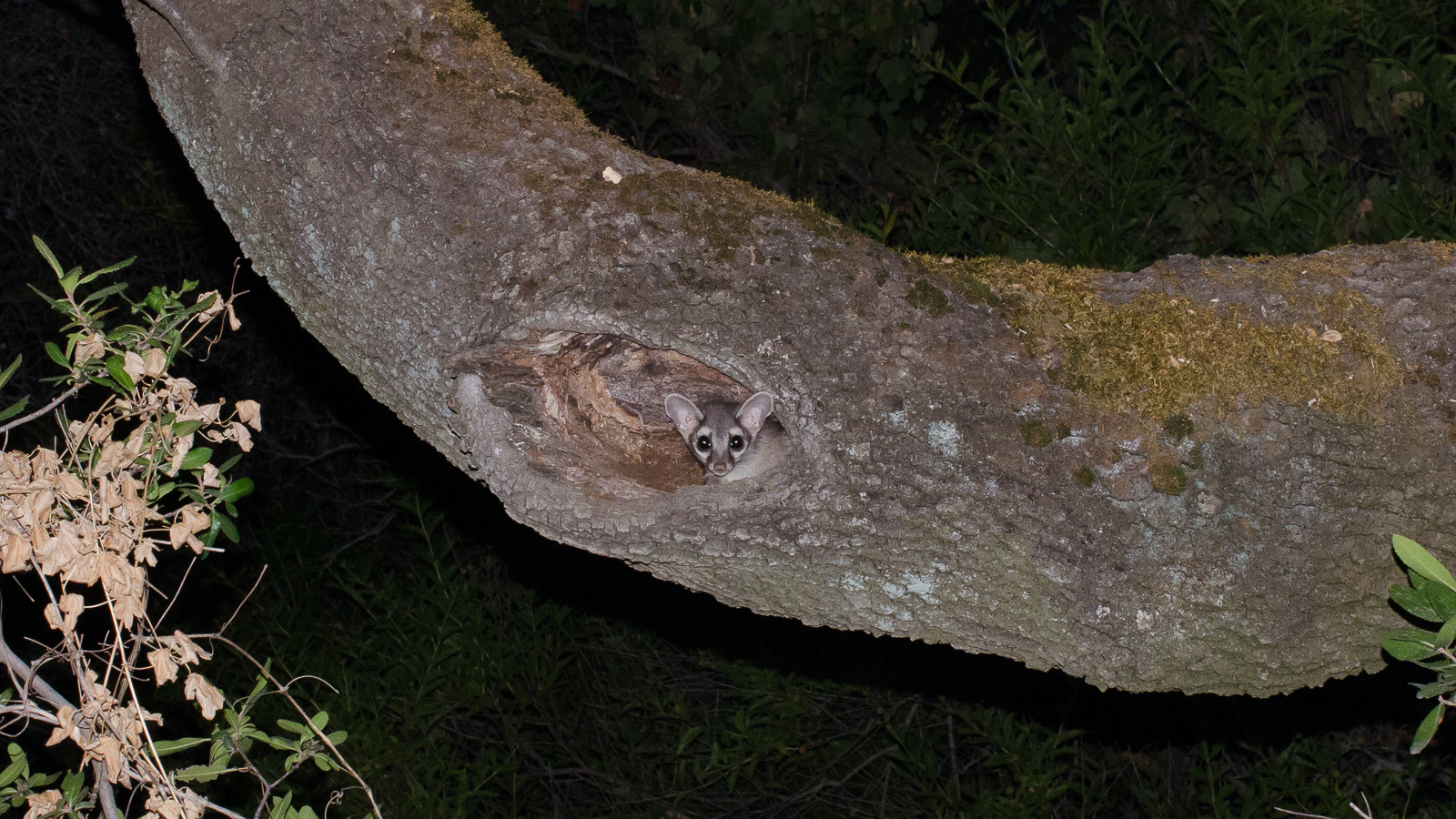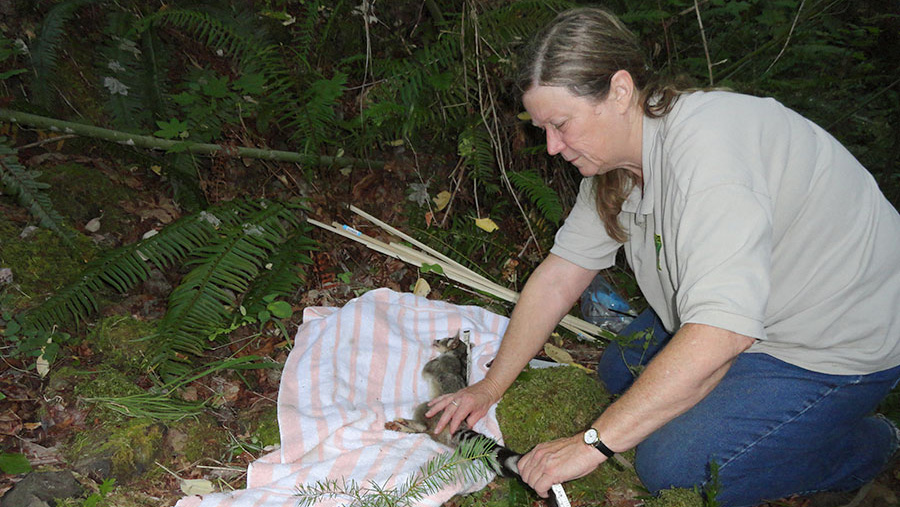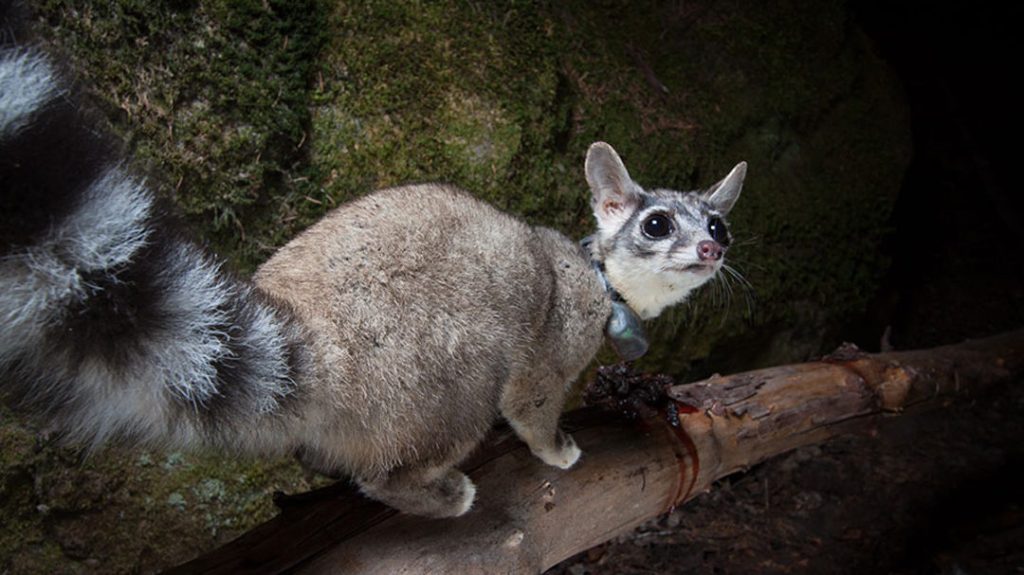Ring-tailed cat, miners cat, bassarisk, cacomistle; the ringtail (Bassariscus astutus) goes by many names. A ringtail by any name is just as cute.
As Rosemary Stussy, a retired Oregon Department of Fish and Wildlife biologist once put it, “on a scale of one to 10, their cuteness factor is a 15.”
“Cat” likely came into many of the common names for ringtails in part because ringtails are about the size of a house cat and in part because, as legend has it, gold rush era miners once enticed ringtails to live in their cabins as pet mousers.
But the ringtail is not a relative of the cat. And though its scientific name is based on an ancient Greek term for fox (βασσάρα), it is not a relative of the fox either. It is — as you may have guessed by the lovely long, ringed tail — more closely related to the raccoon. Both are members of the Procyonid family.
How to Spot a Ringtail
You may know ringtails as a desert southwest species (state mammal of Arizona), but ringtails have a much wider range. They can be found all the way up the west coast into southwestern Oregon and northeast as far as Oklahoma.
Ringtails are nocturnal, solitary, and sparsely populated throughout their range — factors that can make them a challenge to see in the wild. Watch for them at night in trees and shrubs near riparian areas (close to rivers and streams). Around February through May, when ringtails are breeding, you could catch sight of them during daylight hours.

Your best chance of seeing ringtails is at parks and preserves in the U.S. Southwest. Campsites in Grand Canyon National Park are frequently raided by crafty ringtails. Carlsbad Caverns National Park is another ringtail hotspot. Arizona has many birding lodges that put up an array of feeders, and these can attract other wildlife including ringtails. This is how I saw my first ringtails recently near Santa Rita Lodge in Madera Canyon (not to mention a coati and several bird species).
Though they are best known as shy creatures of forests, deserts and rocky areas, ringtails adapt well to living in disturbed areas and are frequently found near man-made buildings. You could have a ringtail living in your yard — they’ve rarely been known to show up in an attic.
“I found about six dens using radio-tracking equipment,” Stussy says. “None were up in trees. They were either down in a hole under a log or between boulders below the high-water mark of a lake – they would use the den in the summer when the water was low.”
If you can’t see a ringtail in the wild, it’s worth visiting a zoo to see one up close. The Oregon Zoo was home to ringtail kits last year.
Ringtail Tales
Ringtails are unusually carnivorous for a Procyonid. The bulk of their diet comes from animal matter (rodents, rabbits, squirrels, insects, birds, reptiles, frogs and carrion!). Ringtails do have a sweet tooth and eat fruit and nectar when available in the wild – Stussy attracted them to camera traps was with a mixture of raisins, jam, and a commercial “ringtail lure.”
Ringtails are sometimes prey to larger predators like great-horned owls, bobcats and coyotes.
When threatened the ringtail bristles the hair on its tail and arches it over its back to make itself appear larger (perhaps another reason for the cat comparison). As a final line of defense, ringtails will release a foul-smelling secretion and scream at a high pitch.
“They’re easily spooked,” says Stussy. “always jumping to the side. Their main predator is the great horned owl and I’ve seen video of a fisher making off with one in the snow. They have to watch out above and below.”

Mammals from ringtails to lemurs to tigers have rings on their tails, but the evolutionary benefit of this trait is not fully understood. It is thought that arboreal, nocturnal mammals like the ringtail might use their tails for communication. Some also hypothesize that it is a kind of camouflage or at least a distraction so that if predators do attack a ringtail, they are more likely to catch the readily visible tail, missing vital organs and giving the ringtail a chance to escape.
Ringtails do posture with their tail. Stussy saw in camera trap footage that ringtails sometimes raise their tail like a skunk in what looks like an aggressive gesture or arch it prettily over their back.
“They use their tail like a squirrel for balancing,” Stussy explains. “They can climb like crazy.”

Ringtails are top notch acrobats. In addition to the help from their tails, they have semi-retractable claws to get a good grip on rocks or tree branches and their hind feet can rotate at least 180 degrees – allowing them to quickly climb head-first down trees and rock faces.
Other incredible climbing behaviors include “chimney stemming” (i.e. pressing their feet against one wall and their back against another like the Grinch climbing up a chimney), “ricocheting” like a video game character bouncing back and forth between more distant walls, and “power leaping” accurately across large distances.
Conservation Needs
The IUCN classifies ringtails as least concern for conservation because of their wide distribution and ability to adapt to human inhabited areas. However, there is limited information on population densities and trends across their range, which makes it difficult to assess conservation needs.
“What is their range? Is it expanding or contracting? It would take a lot of effort to find out. Their home ranges are very small,” Stussy explains. “It needs more work like a lot of things. I hate to think of ringtails going the way of the fisher and nobody’s even looking at them to know it.”

Efforts are underway in Oregon to improve methods of assessing ringtail density as part of the Oregon Conservation Strategy. Stussy’s research initiated an effort to create a consistent ringtail monitoring protocol for Oregon using camera traps. Progress has been slow in part because it is currently unclear whether a low number of sightings in an area is a sign that there are low numbers of ringtails or that the protocol has failed for some other reason (like bears stealing the ringtail bait).
“My work generated a lot of interest,” Stussy says. “One article in the newspaper led to about a hundred calls from people who wanted to report seeing them.”
One promising area for future ringtail research is citizen science. If citizens could capture an image of a ringtail and report the sighting to a centralized database, that would provide far more data for the range and abundance of ringtails in the US than biologists are currently able to capture on their own.
There is not yet, to my knowledge, a dedicated ringtail citizen science project. In the meantime, you can report your ringtail (and other nature) sightings to iNaturalist.




Join the Discussion